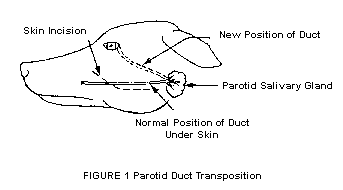We are frequently asked the following questions regarding dry eye in animals. The answers are intended as general responses to increase your understanding. Please feel free to ask any additional questions you may have.
Adobe Acrobat PDF View: download KCS/Dry Eye handout ![]()
WHAT IS KERATOCONJUNCTIVITIS SICCA (DRY EYE)?
The tear film consists of 3 layers: A superficial lipid (oily) layer which decreases evaporation, a middle aqueous layer which contributes 90% of the tear film, and a deep mucin layer which facilitates spreading of the tears over the cornea.
Keratoconjunctivitis sicca (KCS) occurs whenever there is decreased production of tears or increased evaporation or break-up of the tear film. The problem is most common in dogs but occasionally occurs in cats and horses. Usually the problem arises as a decrease in aqueous tear production which may occur as a result of toxic or inflammatory degeneration of the lacrimal glands (certain drugs, viruses, etc have been incriminated), damage to the innervation of the lacrimal glands, or chronic conjunctivitis. In many cases no specific cause can be identified. When the aqueous tear production decreases, mixing of the oily and mucin layers occurs producing a thick, yellowish, ropy discharge which clings to the eye. Drying of the cornea produces irritation which results in vascularization, pigmentation, and scarring of the cornea.
HOW DO YOU TREAT IT?
Treatment for KCS involves 3 essential components:
- Stimulation of tear production.
a) Tear production is best stimulated by the topical administration of cyclosporine formulation to the eyes twice daily. Usually 4-6 weeks (sometimes longer) is required for tear production to improve. Usually treatment must be continued for life to maintain tear production, but it is possible in some cases to reduce usage to once daily or every other day. This is especially true if KCS is detected early before severe drying is present.
b) The oral administration of pilocarpine 1-3 times daily may stimulate tear production and was used extensively prior to the topical use of cyclosporine. This drug occasionally causes excessive salivation and, rarely, vomiting or diarrhea. If these side effects occur, discontinue use and consult your veterinarian. - Control of ocular inflammation and infection through the topical application of an antibiotic-steroid preparation. Occasionally antibiotics may be given orally.
- Tear replacement until return of normal tear secretion. Artificial tear solutions (Ultra Tears, Isopto Tears, Tears Naturale, Adsorbotears, and many others) are valuable in replacing moisture and helping to dilute and wash away thick secretions and dried exudates. Lubricating tear ointments (Lacrilube, Duratears, Tears Renewed, etc.) help to protect the eye and can be administered at bedtime and at times when tears cannot be applied often enough.
HOW LONG IS TREATMENT NECESSARY?
Usually 4-6 weeks is required before any improvement in tear production is noted although the above treatment should result in marked improvement of the clinical signs. If no improvement in tear production is noted by 8 weeks following the initiation of treatment the probability for return of normal function is poor, and tear replacement must be continued for life unless a parotid duct transposition is performed.

The parotid duct transposition is a surgical procedure in which the duct from the parotid salivary gland is moved from where it empties into the mouth and sutured in the conjunctival sac of the eye (Figure 1). The secretion from the parotid salivary gland is watery and provides an acceptable substitute for the aqueous tears. This surgery has a success rate of approximately 95%.
